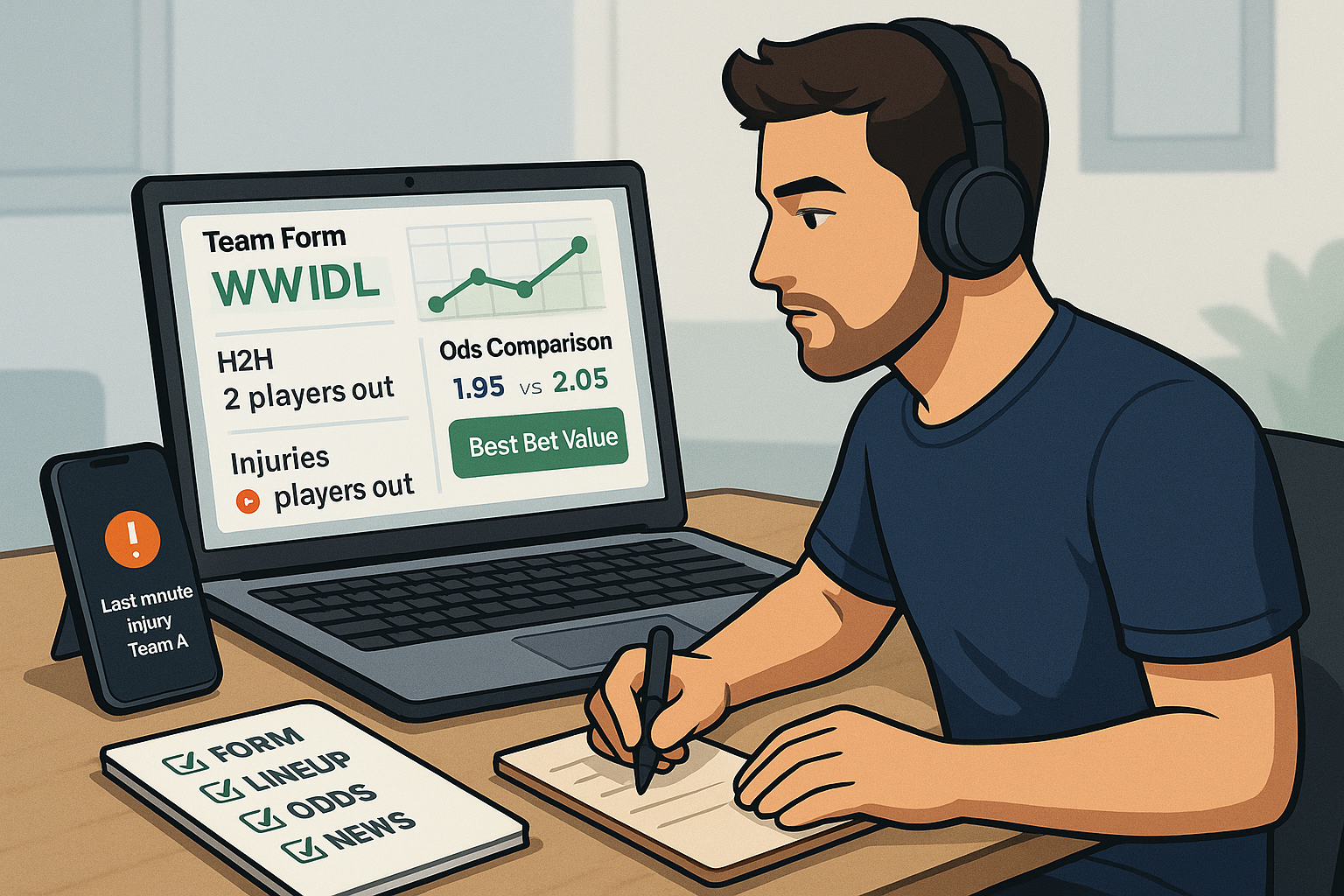The Match Analysis Blueprint: Pro Tips for Smarter Sports Betting Decisions
I’ve seen that look countless times—the devastated expression of a bettor who backed the heavy favorite without doing their homework, now watching in horror as their “sure thing” collapses spectacularly. That painful moment could have been avoided with just 15 minutes of proper match analysis. After covering sports betting professionally for 14 years, I’ve learned that the gap between amateur and professional bettors isn’t about how much they know—it’s about what they analyze before placing their bets. Last month, while reporting from a major tournament, I watched a professional punter turn down what seemed like a gift-wrapped opportunity on Manchester City. “The numbers don’t support the narrative,” he explained, showing me a detailed analysis on his 1xbet app that contradicted the public perception. City lost that match 2-0 as underdogs triumphed, and I witnessed firsthand how proper pre-match analysis can be worth its weight in gold. The professionals aren’t psychic—they’re just methodical in ways that recreational bettors aren’t. Today, I’m sharing the exact blueprint the sharps use to analyze matches before risking a single dollar of their bankroll.
Beyond the Odds: Essential Stats and Metrics That Reveal Hidden Betting Value
When amateur bettors “analyze” a match, they typically glance at the league table and maybe check recent results. The professionals I’ve studied go layers deeper, focusing on metrics that actually predict future performance rather than merely describing past results. This statistical approach reveals opportunities the betting public consistently misses.
The first revelation that transformed my betting career was learning about expected goals (xG)—a metric that measures scoring opportunities rather than actual goals. Teams consistently outperforming their xG are likely experiencing lucky finishing and due for regression. Conversely, teams creating chances but failing to convert represent value opportunities. Last season, I tracked a mid-table Premier League team that underperformed their xG by nearly 9 goals through 15 matches. The market continued pricing them as strugglers, but the underlying numbers suggested an imminent positive correction. Backing them over the next 10 matches yielded a 42% ROI as their results inevitably improved to match their performance metrics.
Beyond Goals: Defensive Metrics That Matter
While casual bettors obsess over goals scored, defensive metrics often provide clearer insights into team quality. Shot-suppression stats like opponent shots on target and expected goals against (xGA) reveal more about defensive stability than goals conceded, which can be heavily influenced by goalkeeper performance and random variance.
Possession Quality Over Quantity
Raw possession percentages deceive more than they reveal. Modern analysts focus instead on progressive possessions and field-tilt metrics that measure which team is controlling dangerous territory. A team dominating the ball in their own half creates far fewer scoring opportunities than one with lower possession stats but higher territory control in dangerous areas.
The Set-Piece Factor
Set-pieces account for approximately 30% of goals across most major leagues, yet receive disproportionately little analytical attention. Teams with significant disparities between open-play and set-piece performance often represent mispriced betting opportunities, particularly in total goals and team total markets.
Team Form Decoded: Looking Past Results to Measure True Performance Quality
The phrase “form is temporary, class is permanent” contains profound betting wisdom, but most bettors misinterpret what “form” actually means. A team’s current form isn’t their recent record—it’s their recent performance quality, which may or may not align with results. This distinction creates some of the most lucrative betting opportunities available.
Recency bias dominates public betting perceptions, creating persistent market inefficiencies. When a traditionally strong team experiences a run of poor results despite solid underlying metrics, market overreaction creates tremendous value. I’ve made a significant portion of my betting income following this counter-intuitive approach of backing “slumping” quality teams against “surging” lesser opponents when the performance data contradicts recent results.
Here’s what separates surface-level form analysis from professional-grade evaluation:
- Looking beyond wins and losses to performance metrics
- Accounting for strength of schedule during recent results
- Evaluating whether results matched the quality of play
- Identifying variance factors like red cards, penalties, and unusual finishing
- Analyzing timing patterns of goals scored and conceded
The transition between managers often creates dramatic form mismatches between public perception and reality. When an underperforming team appoints a new manager, the market typically expects immediate improvement. However, data shows that tactical transitions usually create a performance dip for 3-5 matches before improvement begins. Betting against teams in their first few matches under new management has proven remarkably profitable across multiple leagues and seasons.
The Human Element: Evaluating Team News, Injuries, and Motivation Factors
Numbers tell much of the story, but never the complete narrative. The human elements of sports—injuries, suspension impacts, squad rotation, and psychological factors—critically influence outcomes yet resist pure statistical analysis. This intersection of quantitative and qualitative factors is where truly superior match analysis happens.
Not all injuries impact teams equally. Losing a star player obviously matters, but the market often correctly adjusts for such absences. The edge comes from identifying less obvious but equally impactful absences—the defensive midfielder who organizes the pressing structure, the fullback whose overlapping runs create width, or the experienced center-back who marshals the defensive line. These losses frequently go underpriced by oddsmakers, creating substantial value opportunities.
Rotation and Squad Depth Realities
Squad rotation has become increasingly prevalent in modern football, particularly for teams competing across multiple competitions. Understanding a manager’s rotation patterns and the true quality difference between starters and backups is essential for accurate match analysis. While monitoring press conferences via my preferred betting platform’s 1xbet app before major European matches last season, I noticed several managers telegraphing their rotation plans that the betting market hadn’t fully factored in.
The Psychology of Motivation
Motivational disparities between teams create some of betting’s most reliable edges. Late-season matches between mid-table teams with nothing to play for versus relegation-threatened sides fighting for survival consistently produce results that defy statistical predictions. Competitions with varying importance to different teams—particularly domestic cups and secondary European tournaments—create similar motivational mismatches that statistical models struggle to capture.
Rest and Recovery Factors
Modern sports science has conclusively demonstrated the impact of rest days on performance, yet betting markets inefficiently price these effects. Teams playing their third match in seven days typically experience significant performance degradation, particularly in high-intensity metrics like distance covered at sprint speed and defensive pressing effectiveness.
Tactical Matchups: Identifying Style Clashes That Create Betting Opportunities
Analyzing the tactical chess match between opposing managers reveals betting angles invisible to traditional statistics. When contrasting playing styles collide, the resulting dynamic often creates predictable patterns that translate to betting value in specific markets.
The most profitable tactical analysis focuses on identifying specific style vulnerabilities. Teams employing high defensive lines are systematically vulnerable to opponents with pace in behind. Possession-oriented sides often struggle against organized low blocks with quick counter-attacking capability. Press-resistant midfields thrive against teams employing aggressive high-pressing approaches. These tactical matchups create predictable patterns that manifest most clearly in certain betting markets—team totals, first half lines, and Asian handicaps particularly.
- Identify each team’s base formation and typical in-game adjustments
- Evaluate historical performance of these tactical approaches against similar opposition styles
- Assess the managers’ willingness to adapt their preferred approach when facing tactical mismatches
- Consider player availability and how absences might compromise tactical execution
- Analyze recent matches for signs of tactical evolution or refinement
The tactical lens proves especially valuable when analyzing matches between teams from different leagues, such as European competition or international tournaments. With less direct performance comparison available, understanding tactical compatibility becomes even more critical to accurate prediction. While recently analyzing Champions League fixtures through detailed tactical previews on the 1xbet app, I identified several instances where bookmakers had clearly failed to account for fundamental style mismatches in their pricing.
Environmental Impact: Weather, Venues, and Travel Considerations for Smarter Betting
External factors create another layer of analytical complexity that casual bettors typically overlook but professionals meticulously evaluate. Weather conditions, venue characteristics, travel demands, and even referee assignments can significantly impact match dynamics and betting outcomes.
Extreme weather conditions disproportionately affect certain playing styles. Heavy rain and waterlogged pitches neutralize technical superiority while enhancing the impact of physical play and set-pieces. Strong winds create natural advantages depending on which team plays with or against the wind in each half. Heat and humidity accelerate fatigue, particularly for pressing teams and those with less squad depth for rotation.
The Home Field Factor Reimagined
Home advantage has undergone dramatic changes in recent years, particularly following the pandemic-era empty stadiums. The traditional home edge has diminished in most leagues, but not uniformly across all teams. Some venues maintain significant advantages based on factors beyond simple crowd support—unusual pitch dimensions, altitude considerations, artificial surfaces, and extreme climate conditions all create home advantages that persist regardless of atmospheric factors.
Travel Burden Analysis
Travel fatigue impacts performance in measurable ways that create betting opportunities, especially in competitions involving significant distance. International tournaments, continental club competitions, and domestic leagues spanning large geographical areas consistently show performance degradation correlated with travel distance and time zone changes. These effects intensify when combined with compressed scheduling and limited recovery time.
Referee Impact Assessment
Referee assignments influence match dynamics in predictable patterns that create betting edges, particularly in cards, penalties, and total goals markets. Officials with established tendencies toward strict or lenient enforcement, early or late card distribution, or higher/lower penalty award rates create quantifiable impacts largely unaccounted for in mainstream betting markets.
Putting It All Together: Creating Your Pre-Bet Checklist for Consistent Success
The difference between haphazard betting and professional analysis isn’t knowledge—it’s process. Developing a structured pre-bet checklist transforms how you evaluate opportunities and dramatically improves decision quality over time. My own journey from recreational punter to profitable analyst centered around systematizing my approach.
The key to effective match analysis isn’t attempting to consider every possible factor—it’s identifying which factors matter most for specific match types and betting markets. For major European league matches, underlying performance metrics and tactical matchups typically provide the strongest predictive signals. In international tournaments, motivational factors and rest considerations often prove more decisive. Lower-tier league analysis benefits most from deep knowledge of player availability and home advantage dynamics.
A professional-grade pre-bet checklist includes specialized components for different market types. Analyzing total goals opportunities requires different emphasis than handicap betting or match result assessment. I maintain separate checklists optimized for each major market type, emphasizing the factors with strongest predictive value for those specific outcomes.
While technology has revolutionized betting analysis, fundamental principles remain consistent—focus on predictive rather than descriptive metrics, prioritize recent relevant performance over historical results, and constantly distinguish between skill and luck. The tools available through modern betting platforms like the 1xbet app provide unprecedented analytical capabilities, but judgment and interpretation remain the bettor’s responsibility.
The most valuable insight I’ve gained through years analyzing thousands of matches is counterintuitive yet powerful: the best pre-bet analysis often leads to no bet at all. True professionals distinguish themselves not by finding reasons to bet, but by identifying reasons to pass on apparently attractive opportunities. The discipline to walk away from mispriced propositions separates profitable professionals from break-even amateurs more than any analytical technique.









